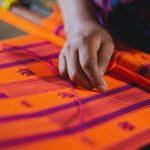Are you tired of your chiffon fabric looking limp and lifeless? Well, you’re in luck! In this article, we’re going to show you how to stiffen chiffon fabric and bring it back to its former glory.
By understanding the nature of chiffon fabric and choosing the right stiffening method, you’ll be able to achieve that desired crispness and structure.
Whether it’s using starch, gelatin, or fabric stiffener, we’ve got you covered. Get ready to transform your chiffon garments with these simple and effective techniques.
Table of Contents
Understanding Chiffon Fabric
To understand chiffon fabric better, you should know that it is a lightweight and sheer material. Chiffon is commonly used in clothing and accessories due to its delicate and flowy nature. There are different types of chiffon fabric, including silk chiffon, polyester chiffon, and nylon chiffon.
Silk chiffon is considered the most luxurious and expensive, while polyester and nylon chiffon are more affordable options. Chiffon can be used for various purposes, such as making elegant evening gowns, scarves, and curtains.
When it comes to caring for chiffon fabric, it is essential to handle it with care. Chiffon should be hand-washed in cold water using a mild detergent. Avoid using harsh chemicals or bleach, as they can damage the fabric. After washing, gently squeeze out excess water and hang the garment to dry. It is best to avoid wringing or twisting chiffon, as it can cause the fabric to stretch or lose its shape.
To remove wrinkles from chiffon fabric, you can try steaming it with a garment steamer or ironing it on a low setting. However, it is crucial to use a pressing cloth to protect the fabric from direct heat. By following these care instructions, you can ensure that your chiffon fabric stays beautiful and retains its delicate appearance.
Importance of Stiffening Chiffon
The importance of stiffening chiffon is that it adds structure and shape to the delicate material. When chiffon is stiffened, it becomes easier to work with and holds its shape better, making it ideal for creating beautiful garments and accessories.
Here are three benefits of stiffened chiffon and the challenges you may face when trying to achieve it:
-
Enhanced drape: Stiffened chiffon has a more defined and controlled drape, allowing you to create elegant and flowing designs. The added structure adds volume and movement to your creations, making them look more polished and professional.
-
Increased durability: Stiffening chiffon helps to strengthen the fabric, making it less prone to tearing or fraying. This is particularly important when working with delicate and sheer chiffon, as it can be easily damaged during sewing or wearing.
-
Versatile styling options: Stiffened chiffon can be manipulated into various shapes and forms, giving you endless possibilities for creative designs. Whether you want to create ruffles, pleats, or structured silhouettes, a stiffened chiffon will hold its shape and allow you to achieve the desired look.
However, stiffening chiffon can present some challenges. The delicate nature of the fabric makes it susceptible to damage from harsh chemicals or excessive heat. Finding the right balance of stiffness without compromising the fabric’s delicate appearance can be tricky. It’s important to choose the right stiffening method and products to ensure the best results.
Preparing Chiffon Fabric for Stiffening
Preparing chiffon for stiffening can be a delicate process, requiring careful consideration of the fabric’s fragility and the desired level of stiffness. To achieve the perfect balance, you can explore various fabric stiffener alternatives. Here is a table illustrating some options you can consider:
| Fabric Stiffener Alternatives |
|---|
| Cornstarch |
| Gelatin |
| White glue |
Each of these alternatives has its own advantages and considerations. Cornstarch is readily available and can provide a subtle stiffness to chiffon. Gelatin, on the other hand, offers a stronger hold but requires more effort to dissolve and prepare. White glue is another option that can provide a firm stiffness, but it may alter the texture of the fabric slightly.
Before applying any stiffener, it is important to test it on a small, inconspicuous area of the fabric to ensure the desired effect. Additionally, make sure to follow the manufacturer’s instructions or any specific guidelines for the stiffener you choose.
Choosing the Right Stiffening Method
When choosing the right method for stiffening chiffon, it’s important to consider the desired level of stiffness and the specific characteristics of the fabric. There are natural stiffening alternatives that can help you achieve the desired effect without the use of chemicals. Here are three options to consider:
-
Cornstarch: Mix cornstarch with water to create a paste-like consistency. Apply the mixture to the chiffon fabric using a brush or sponge. Let it dry completely before removing any excess powder. This method provides a moderate level of stiffness and is easily washable.
-
Gelatin: Dissolve gelatin powder in warm water according to the package instructions. Submerge the chiffon fabric in the gelatin solution and squeeze out any excess liquid. Hang the fabric to dry, ensuring it is stretched out to maintain its shape. This method provides a firmer stiffness and is best suited for decorative purposes.
-
Sugar water: Create a solution by dissolving sugar in warm water. Dip the chiffon fabric into the solution and wring out any excess liquid. Hang the fabric to dry, allowing it to stiffen as it dries. This method provides a subtle stiffness and is suitable for garments that require a gentle hold.
Stiffening Chiffon With Starch
To achieve the desired level of stiffness for your chiffon, you can use starch as a natural alternative. However, if you prefer to avoid using starch, there are other DIY chiffon stiffening techniques you can try.
One method is to use gelatin. Mix one tablespoon of unflavored gelatin with one cup of water and heat it until the gelatin dissolves completely. Let the mixture cool down and then dip your chiffon fabric into it. Make sure to wring out any excess liquid and hang the fabric to dry.
Another option is to use a fabric stiffener spray. These sprays can be found in craft stores and are designed specifically for stiffening fabrics. Simply spray the fabric evenly and let it dry.
You can also try using a combination of water and white vinegar. Mix equal parts of water and white vinegar in a spray bottle and mist the chiffon fabric. Hang it to dry and the vinegar will help stiffen the fabric.
These DIY techniques can help you achieve the desired stiffness for your chiffon without using starch.
Stiffening Chiffon With Gelatin
When it comes to stiffening chiffon fabric, you may have heard about using starch. However, have you considered using gelatin instead?
In this discussion, we will explore the key points of using gelatin versus starch for stiffening chiffon, including the longevity of the stiffening effect and the impact on fabric texture.
Gelatin Vs. Starch?
If you want to stiffen chiffon fabric, gelatin is more effective than starch. However, if you’re looking for alternative options, there are other substitutes available for both gelatin and starch.
Gelatin alternatives include cornstarch, rice starch, and tapioca starch. These alternatives can provide similar results in terms of stiffening chiffon fabric.
On the other hand, if you prefer using starch, there are also alternatives such as arrowroot starch, potato starch, and wheat starch. These starch alternatives can be used as a substitute for traditional cornstarch or gelatin.
It’s important to note that the effectiveness may vary depending on the specific fabric and desired stiffness. It’s always recommended to test a small sample before applying any stiffening agent to the entire fabric.
Longevity of Stiffening?
The longevity of gelatin and starch stiffening agents may vary depending on the specific fabric and desired results. It is important to choose the best methods for durability when stiffening chiffon fabric. To help you understand the differences, here is a comparison table:
| Stiffening Agent | Longevity | Ease of Application | Flexibility |
|---|---|---|---|
| Gelatin | Moderate | Easy | Limited |
| Starch | Long-lasting | Moderate | High |
As you can see, gelatin provides moderate longevity, while starch offers long-lasting results. Gelatin is easy to apply but has limited flexibility, while starch has moderate ease of application and high flexibility. When choosing a stiffening agent for chiffon fabric, consider the desired longevity and the level of flexibility needed. Starch may be the better option if you want long-lasting stiffness with more flexibility. Keep in mind that the specific fabric and desired results will ultimately determine the best method for durability.
Impact on Fabric Texture?
To achieve the desired texture, you can consider the impact of different stiffening agents on your chosen fabric. The impact on fabric drape can vary depending on the method used.
Stiffening methods comparison can help you choose the best approach for your needs.
When stiffening chiffon fabric, you need to be careful as it is a delicate material. Traditional methods like using starch or gelatin can alter the drape and make the fabric stiffer.
Another option is using fabric stiffeners specifically designed for lightweight fabrics like chiffon. These products provide a more controlled stiffening effect, allowing you to maintain the fabric’s natural drape while still achieving the desired level of stiffness.
Experimenting with different methods will help you find the perfect balance between the desired texture and the fabric’s natural drape.
Stiffening Chiffon With Fabric Stiffener
When it comes to stiffening chiffon fabric, there are alternative methods to consider besides using gelatin. These alternative methods have their own set of pros and cons.
In this discussion, we will explore these methods and weigh the advantages and disadvantages of each.
Alternative Stiffening Methods
If you’re looking for alternative methods to stiffen chiffon fabric, you can try using gelatin or cornstarch. These options provide a cost-effective and easily accessible solution for achieving the desired stiffness.
Here are some best practices to consider when using these alternative methods:
-
Gelatin:
-
Dissolve gelatin in warm water according to the package instructions.
-
Gently dip the chiffon fabric into the gelatin mixture, ensuring it is evenly coated.
-
Hang the fabric to dry, taking care to avoid any wrinkles.
-
Cornstarch:
-
Mix cornstarch with water to create a paste-like consistency.
-
Apply the cornstarch paste onto the chiffon fabric using a brush or sponge.
-
Allow the fabric to dry completely before handling or wearing.
Remember to test these methods on a small, inconspicuous area of the fabric before applying them to the entire garment.
Pros and Cons
One benefit of using alternative stiffening methods is that they are cost-effective and easily accessible. There are several pros and cons to consider when choosing the best products for stiffening chiffon fabric. Here is a table that outlines some of the advantages and disadvantages of different options:
| Product | Pros | Cons |
|---|---|---|
| Spray starch | Easy to use | May leave residue or discolor fabric |
| Gelatin | Provides a strong hold | Can make fabric stiff and uncomfortable to wear |
| Fabric stiffener | Gives a natural look to the fabric | May not provide as strong a hold as other options |
When deciding which product to use, it’s important to weigh the pros and cons to find the best option that suits your needs. Spray starch is a popular choice for its ease of use, but it may leave a residue or discolor the fabric. Gelatin provides a strong hold, but it can make the fabric stiff and uncomfortable to wear. Fabric stiffeners give a natural look, but may not provide as strong a hold as other options. Consider your preferences and the desired outcome when selecting a stiffening method.
Tips and Tricks for Stiffening Chiffon Successfully
To successfully stiffen chiffon fabric, try these tips and tricks.
When choosing the right technique, it’s important to consider the type of chiffon you have and the desired level of stiffness.
One common mistake in stiffening chiffon is using too much starch or sizing, which can make the fabric stiff and crunchy. Instead, opt for a light hand and apply the stiffening agent sparingly.
Another mistake is not allowing enough drying time. Chiffon is a delicate fabric, and rushing the drying process can lead to wrinkles or damage. Be patient and give the fabric enough time to dry naturally.
Additionally, be careful when ironing stiffened chiffon. Use a low heat setting and avoid pressing too hard to prevent any unwanted creases.
Finally, store the stiffened chiffon carefully to maintain its stiffness. Avoid folding or crushing the fabric when not in use to preserve its shape.
Conclusion
In conclusion, stiffening chiffon fabric can be a simple and effective way to add structure and body to your garments or crafts. By understanding the nature of chiffon and the importance of stiffening, you can choose the right method that suits your needs.
Whether it’s using starch, gelatin, or fabric stiffener, following the proper steps and taking some tips and tricks into consideration will ensure successful results. So don’t hesitate to stiffen your chiffon fabric and achieve the desired look and feel for your projects.
- What Is Kona Cotton Fabric? A Complete Guide for Quilters - June 20, 2025
- The Unique Appeal of China Seas’ Outdoor Fabric Line - June 20, 2025
- How to Navigate the Complexities of China’s Fabrication Companies - June 20, 2025






